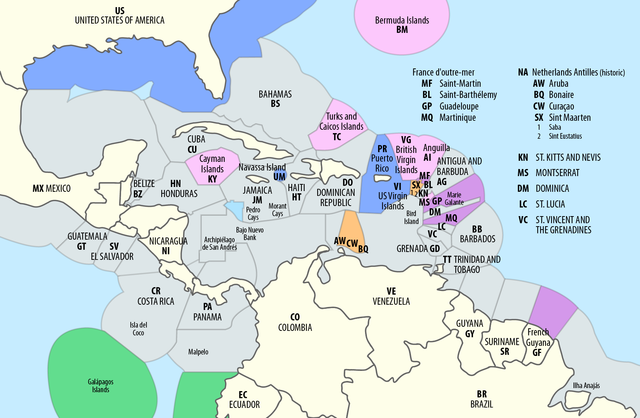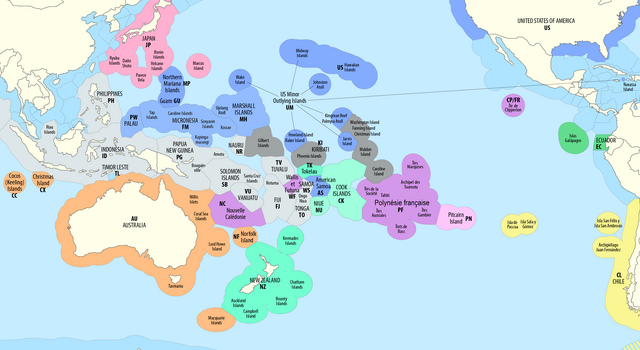Top Qs
Timeline
Chat
Perspective
Borders of the United States
Political boundaries between the United States and neighboring territories From Wikipedia, the free encyclopedia
Remove ads
The United States has land borders with Canada to the North and Mexico to the South and a maritime boundary with Russia to the West, as well as maritime boundaries with several much smaller countries of the diverse Exclusive economic zone of the United States (EEZ).


All of the United States maritime borders with Canada are at least partially disputed, and its territorial claims on three Caribbean islands are disputed.
Remove ads
List
Summarize
Perspective
Maritime borders that are not delineated by bilateral treaty are defined by United States acceptance of the United Nations Convention on the Law of the Sea (UNCLOS), which includes the convention's exclusive economic zone boundary definitions but does not extend to mineral rights in international waters. United States Minor Outlying Islands (USMOI) are mostly uninhabited, unorganized, and unincorporated.
Remove ads
Custom territories
Insular areas in the Pacific and the U.S. Virgin Islands are not included in the main domestic customs territory which is limited to the 50 states, the District of Columbia, and Puerto Rico.
Border disputes
- Canada
- New Brunswick-Maine maritime border and islands: While the 1984 Gulf of Maine Case submitted to the International Court of Justice[2] established most of Atlantic maritime boundary between the United States and Canada,[3] the parties agreed to exclude from that case Machias Seal Island and North Rock and nearby portions of the maritime boundary. This created a "grey zone" of overlapping claims near the disputed islands (and has contributed to "grey-zone conflict"). Machias Seal Island is occupied by Canada, and the disputed waters are patrolled by both nations. The strength of near-shore maritime claims depend on how the island sovereignty dispute is resolved.
- Strait of Juan de Fuca between Washington State and British Columbia
- Beaufort Sea - Yukon–Alaska dispute
- Dixon Entrance, southern Alaska and coastal British Columbia - Dispute stems from the ambiguity of the Hay–Herbert Treaty in 1903 between the United States and the United Kingdom signed to settle the Alaska boundary dispute, an agreement opposed by Canadian leaders.
- Haiti
- Navassa Island - The US claimed the Navassa island via the Guano Islands Act of 1856. Haiti claimed sovereignty over the island in 1801, but was occupied by the US through gunboat diplomacy.
- Colombia
- Bajo Nuevo Bank - Administered by Colombia, claimed by the US as an unorganized, unincorporated territory.[citation needed]
- Serranilla Bank - Administered by Colombia, claimed by the US as an unorganized, unincorporated territory.
- Tokelau
- Swains Island has been administered by the United States as part of American Samoa since 1925. New Zealand, of which Tokelau is a dependency, recognized U.S. sovereignty in a 1980 treaty.[4] The uninhabited island was claimed for Tokelau in the constitution that was almost adopted in the 2006 Tokelauan self-determination referendum.
Disputed occupation
The United States administers Guantanamo Bay Naval Base on what both countries agree is the sovereign territory of Cuba under a permanent lease obtained under the Cuban–American Treaty of Relations (1903), while Cuba was under American military occupation after the 1898 Spanish–American War. After the Cuban Revolution in the 1950s, Cuba disputed the validity of this lease and ceased cooperating with the base. The boundary is highly militarized, but the United States has maintained control without active fighting.
Remove ads
Enforcement
Summarize
Perspective
Three agencies in the federal Department of Homeland Security split border-related responsibilities. U.S. Customs and Border Protection staffs official border checkpoints, collects tariff duties, and inspects arriving people, and inspects goods being imported by land, sea, and air. U.S. Immigration and Customs Enforcement polices borders away from official points of entry. United States Citizenship and Immigration Services administers immigration procedures.
The United States Coast Guard actively patrols the nation's extensive maritime borders, acting as a law enforcement agency in peacetime. The United States Armed Forces are generally prohibited from domestic law enforcement (including arresting smugglers and illegal immigrants) under the Posse Comitatus Act, but can be activated to secure the border in an emergency or respond to an attack. State and federal National Guard troops and even active-duty military personnel have been used in support roles at the border, which has been controversial and limited by legal complexities.[5][6]
The border search exception to the guarantees in the Fourth Amendment to the United States Constitution against unreasonable search and seizure and requirement for search warrants apply to border checkpoints and areas within 100 miles (160 km) of the border.
Remove ads
See also
References
External links
Wikiwand - on
Seamless Wikipedia browsing. On steroids.
Remove ads
